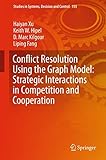Conflict Resolution Using the Graph Model: Strategic Interactions in Competition and Cooperation [electronic resource] / by Haiyan Xu, Keith W. Hipel, D. Marc Kilgour, Liping Fang.
By: Xu, Haiyan [author.] .
.
Contributor(s): Hipel, Keith W [author.] | Kilgour, D. Marc [author.]
| Kilgour, D. Marc [author.] | Fang, Liping [author.]
| Fang, Liping [author.] | SpringerLink (Online service)
| SpringerLink (Online service) .
.
Material type:  BookSeries: Studies in Systems, Decision and Control: 153Publisher: Cham : Springer International Publishing : Imprint: Springer, 2018Edition: 1st ed. 2018.Description: XXXIV, 436 p. 77 illus., 31 illus. in color. online resource.Content type: text Media type: computer Carrier type: online resourceISBN: 9783319776705.Subject(s): Computational intelligence
BookSeries: Studies in Systems, Decision and Control: 153Publisher: Cham : Springer International Publishing : Imprint: Springer, 2018Edition: 1st ed. 2018.Description: XXXIV, 436 p. 77 illus., 31 illus. in color. online resource.Content type: text Media type: computer Carrier type: online resourceISBN: 9783319776705.Subject(s): Computational intelligenceConflict Resolution in Practice -- Decision Making in Perspective -- Conflict Models in Graph Form -- Stability Definitions: Simple Preference -- Stability Definitions: Unknown Preference -- Stability Definitions: Degrees of Preference -- Stability Definitions: Hybrid Preference -- Coalitional Stabilities -- Follow-up Analysis: Conflict Evolution -- Design of a Decision Support System for Conflict Resolution.
This cutting-edge book presents the theory and practice of the Graph Model for Conflict Resolution (GMCR), which is used for strategically investigating disputes in any field to enable informed decision making. It clearly explains how GMCR can determine what is the best a particular decision maker (DM) can independently achieve in dynamic interaction with others. Moves and counter-moves follow various stability definitions reflecting human behavior under conflict. The book defines a wide range of preference structures to represent a DM’s comparisons of states or scenarios: equally preferred, more or less preferred; unknown; degrees of strength of preference; and hybrid. It vividly describes how GMCR can ascertain whether a DM can fare even better by cooperating with others in a coalition. The book portrays how a conflict can evolve from the status quo to a desirable resolution, and provides a universal design for a decision support system to implement the innovative decision technologies using the matrix formulation of GMCR. Further, it illustrates the key ideas using real-world conflicts and supplies problems at the end of each chapter. As such, this highly instructive book benefits teachers, mentors, students and practitioners in any area where conflict arises.


There are no comments for this item.